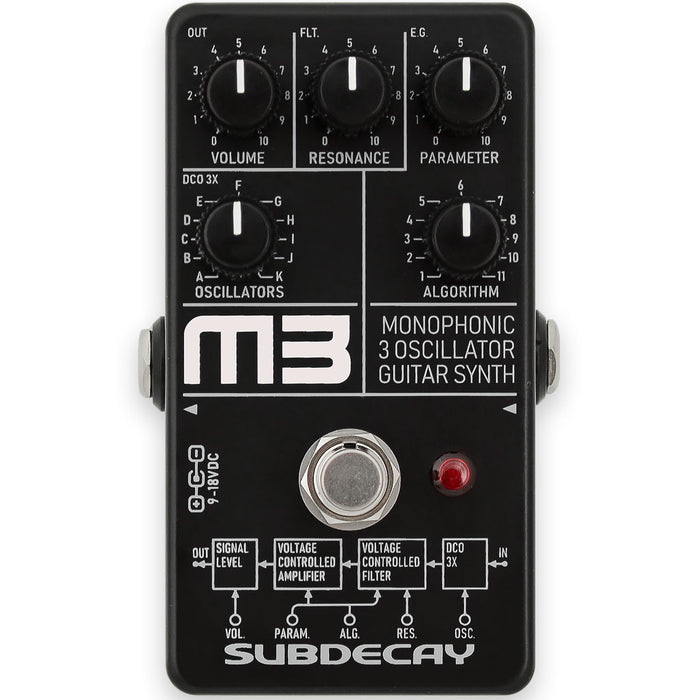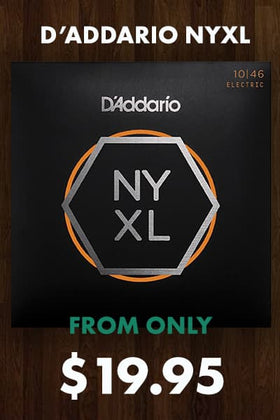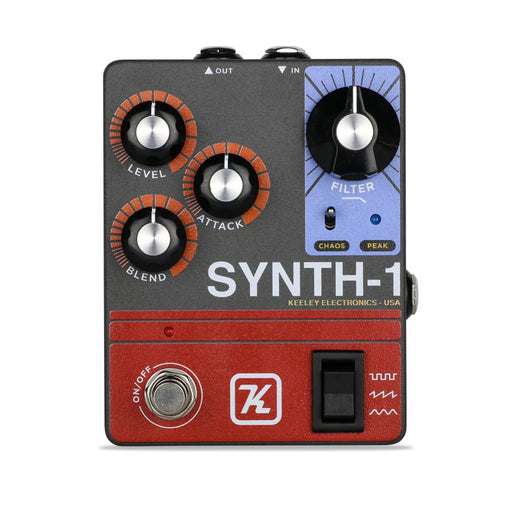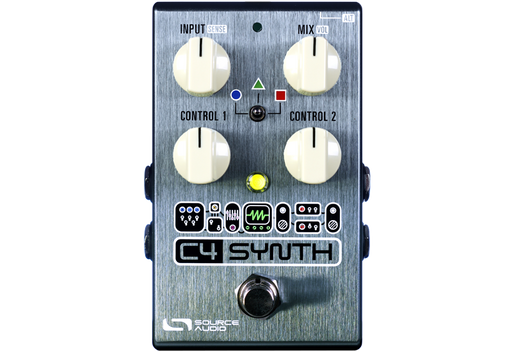
Monophonic Guitar Synthesizer
Based on the Korg MS-20, the M3 brings the sounds of 70s monophonic synthesizers without the modular complications.
Instead of dual oscillators, the M3 employs 3 digitally controlled oscillators for super fat synth sounds that never go out of tune.
Eleven oscillator combinations cover string sounds, analog bass, bell tones, fifths and more. The algorithm knob’s eleven settings further shapes the sound controlling everything from the filter, two envelope generators, LFOs, portamento and more.
70s inspired
The 1970s saw a massive expansion of electronic music instruments. Much like early electric guitars some didn’t know what to make of these electronic synthesizers. Some of these electronic noise makers were almost affordable. (insert if you can afford a truck, you can afford a synthesizer meme)
Ease of use and portability improved as well, but MIDI wasn’t coming until 1983. Saving patches usually meant writing them down in a notebook. This was still a vast improvement from earlier interconnected cabinets in studios that needed constant tuning and maintenance and were near impossible to use live.
This era created some of the most iconic synthesizers of all time. We’ve packed the essence of 70s analog monosynth into the M3. Don’t let the simplified controls deceive you. The M3 incorporates the following: (Synth Speak warning)
Control and structure
Three oscillators.
Three LFOs (PWM & pitch for each oscillator, and the filter)
Two envelope generators. (filter & AMP)
Voltage controlled analog resonant filter.
Voltage controlled amplifier
Synths of this era rarely had more than two oscillators per voice. A single LFO was common. Many synthesizers used a single envelope generator to control the filter and the amplifier. So how did we fit all this 70s goodness in a stompbox? We borrowed some tricks from the 80s. As MIDI became a synthesizer standard many of those “analog” synthesizers used digital control. Analog envelope followers and LFOs were replaced with digital technology. The synth world that was still analog moved on from voltage controlled oscillators to digitally controlled oscillators. Often the same processors found in computers were found in synthesizers controlling everything.
User friendly for guitarists-
Essentially the M3 has 121 tweakable patches. The oscillator knob selects between eleven oscillator combinations. The algorithm knob selects filter, amp and LFO settings. The parameter knob allows you to alter each algorithm in different ways.
Oscillators
Each of the M3’s oscillators are capable of sawtooth waves or pulse waves with variable pulse width modulation. One of the LFOs controls the PWM. Another controls the pitch and is used to detune the oscillators for a chorus effect.
Controls:
Oscillators: This knob sets between 11 different oscillator selections.
A B & C Saw wave ensembles: The basis for the string machines of the past. Can also capture some horn sounds.
D E & F Basses: A mix of lower frequency saw and PWM waves.
G Fifth: Two oscillators track the input pitch with one oscillator offset by a 5th for that classic 5th synth sound.
H Major Triad: This is more of an ode to 90s electronic music than the 70s. We won’t judge you for using it!
I octaves: Stacked octave saw waves.
J: Two square waves and upper octave 5th: This was a common way synthesizers attempted to capture bell and chime timbers, or even electric piano.
K Stacked Squares: All three oscillators run squarewaves in unison. Perfect for synth leads.
Algorithms: This controls everything else. Filter and Amp envelopes, LFOs, portamento and pitch follow for the filter. Additionally one or more setting can be tweaked with the parameter knob.
1 Wide open: Parameter controls filter offset. The envelopes are wide open with moderate release. This is an example of one of the most simply synth settings.
2 String Envelope: Parameter controls filter offset. A moderate attack with high sustain and near reverb like release. Works well with string oscillator settings.
3 portamento: Parameter controls filter offset. The oscillators will glide smoothly from note to note. A classic synth lead trick that never goes out of style.
4 Decay: Parameter controls filter and amp decay length from just a blip to two seconds.
5 Decay/sustain 1: Parameter controls filter sustain. Another common synth sound. A quick decay that doesn’t decay all the way.
6 Decay/sustain 2: Similar to #5, but slower and brighter.
7 Fade: Parameter controls decay. Wide downward filter sweep.
8 Vibrato: Parameter controls Filter LFO speed. Slow decay with filter modulation.
9 Fast Modulation: Parameter controls Filter modulation speed into the audio range from roughly 2 octaves down to two octaves up. This creates a faux ring modulation effect.
10 Slow attack: Parameter controls amp attack. like a reverse or swell effect. the notes fade in instead of out.
11 Filter Rise: Parameter controls the rise rate. Each note triggers a deep rising sweep of the filter. The Amp fades out as the rise peaks.
Volume: You know what this one does, right? Turn it up to make it louder.
Resonance: Controls the resonance of the filter.
Parameter: Control varies depending on algorithm setting.
Warranty & Returns
All New products are covered by the manufacturers new warranty. Please check their website for the length of warranty and warranty conditions. If an item you receive is faulty get in touch with us ASAP. Second Hand products come with a 4 week warranty from us. If there is an issue let us know ASAP! This covers normal use and does not cover accidental damage, misuse, wrong power plugged into it, modding, water damage or any other damage caused by mistreatment. Just treat it nice and all will be good!
Shipping
We send A LOT of packages every week so don't worry about the shipping side of things!
We've never lost a thing and your awesome new gear will be packed up really well to avoid any damage in transit.
If your order comes in before 2pm we will ship it same day. Most of the time we pack things up all the way to 4pm so just call if you need it to leave same day after 2pm.
We ship mainly with Australia Post but may use a courier depending on location and size of the package.
Free Post ships with Australia Post standard and expected shipping times are between 4-6 business days depending on location. It will be longer to outside of metro and rural areas.
Express Post will usually be with you next business day in metro areas of QLD, NSW, SA, VIC and TAS. WA will take 2 days to metro and extra days after that to out side metro and rural areas.
Everything we ship has a tracking number with the exception of some power cables and smaller envelope packages. You will be emailed tracking once your order has been shipped!
Monophonic Guitar Synthesizer
Based on the Korg MS-20, the M3 brings the sounds of 70s monophonic synthesizers without the modular complications.
Instead of dual oscillators, the M3 employs 3 digitally controlled oscillators for super fat synth sounds that never go out of tune.
Eleven oscillator combinations cover string sounds, analog bass, bell tones, fifths and more. The algorithm knob’s eleven settings further shapes the sound controlling everything from the filter, two envelope generators, LFOs, portamento and more.
70s inspired
The 1970s saw a massive expansion of electronic music instruments. Much like early electric guitars some didn’t know what to make of these electronic synthesizers. Some of these electronic noise makers were almost affordable. (insert if you can afford a truck, you can afford a synthesizer meme)
Ease of use and portability improved as well, but MIDI wasn’t coming until 1983. Saving patches usually meant writing them down in a notebook. This was still a vast improvement from earlier interconnected cabinets in studios that needed constant tuning and maintenance and were near impossible to use live.
This era created some of the most iconic synthesizers of all time. We’ve packed the essence of 70s analog monosynth into the M3. Don’t let the simplified controls deceive you. The M3 incorporates the following: (Synth Speak warning)
Control and structure
Three oscillators.
Three LFOs (PWM & pitch for each oscillator, and the filter)
Two envelope generators. (filter & AMP)
Voltage controlled analog resonant filter.
Voltage controlled amplifier
Synths of this era rarely had more than two oscillators per voice. A single LFO was common. Many synthesizers used a single envelope generator to control the filter and the amplifier. So how did we fit all this 70s goodness in a stompbox? We borrowed some tricks from the 80s. As MIDI became a synthesizer standard many of those “analog” synthesizers used digital control. Analog envelope followers and LFOs were replaced with digital technology. The synth world that was still analog moved on from voltage controlled oscillators to digitally controlled oscillators. Often the same processors found in computers were found in synthesizers controlling everything.
User friendly for guitarists-
Essentially the M3 has 121 tweakable patches. The oscillator knob selects between eleven oscillator combinations. The algorithm knob selects filter, amp and LFO settings. The parameter knob allows you to alter each algorithm in different ways.
Oscillators
Each of the M3’s oscillators are capable of sawtooth waves or pulse waves with variable pulse width modulation. One of the LFOs controls the PWM. Another controls the pitch and is used to detune the oscillators for a chorus effect.
Controls:
Oscillators: This knob sets between 11 different oscillator selections.
A B & C Saw wave ensembles: The basis for the string machines of the past. Can also capture some horn sounds.
D E & F Basses: A mix of lower frequency saw and PWM waves.
G Fifth: Two oscillators track the input pitch with one oscillator offset by a 5th for that classic 5th synth sound.
H Major Triad: This is more of an ode to 90s electronic music than the 70s. We won’t judge you for using it!
I octaves: Stacked octave saw waves.
J: Two square waves and upper octave 5th: This was a common way synthesizers attempted to capture bell and chime timbers, or even electric piano.
K Stacked Squares: All three oscillators run squarewaves in unison. Perfect for synth leads.
Algorithms: This controls everything else. Filter and Amp envelopes, LFOs, portamento and pitch follow for the filter. Additionally one or more setting can be tweaked with the parameter knob.
1 Wide open: Parameter controls filter offset. The envelopes are wide open with moderate release. This is an example of one of the most simply synth settings.
2 String Envelope: Parameter controls filter offset. A moderate attack with high sustain and near reverb like release. Works well with string oscillator settings.
3 portamento: Parameter controls filter offset. The oscillators will glide smoothly from note to note. A classic synth lead trick that never goes out of style.
4 Decay: Parameter controls filter and amp decay length from just a blip to two seconds.
5 Decay/sustain 1: Parameter controls filter sustain. Another common synth sound. A quick decay that doesn’t decay all the way.
6 Decay/sustain 2: Similar to #5, but slower and brighter.
7 Fade: Parameter controls decay. Wide downward filter sweep.
8 Vibrato: Parameter controls Filter LFO speed. Slow decay with filter modulation.
9 Fast Modulation: Parameter controls Filter modulation speed into the audio range from roughly 2 octaves down to two octaves up. This creates a faux ring modulation effect.
10 Slow attack: Parameter controls amp attack. like a reverse or swell effect. the notes fade in instead of out.
11 Filter Rise: Parameter controls the rise rate. Each note triggers a deep rising sweep of the filter. The Amp fades out as the rise peaks.
Volume: You know what this one does, right? Turn it up to make it louder.
Resonance: Controls the resonance of the filter.
Parameter: Control varies depending on algorithm setting.
Warranty & Returns
All New products are covered by the manufacturers new warranty. Please check their website for the length of warranty and warranty conditions. If an item you receive is faulty get in touch with us ASAP. Second Hand products come with a 4 week warranty from us. If there is an issue let us know ASAP! This covers normal use and does not cover accidental damage, misuse, wrong power plugged into it, modding, water damage or any other damage caused by mistreatment. Just treat it nice and all will be good!
Shipping
We send A LOT of packages every week so don't worry about the shipping side of things!
We've never lost a thing and your awesome new gear will be packed up really well to avoid any damage in transit.
If your order comes in before 2pm we will ship it same day. Most of the time we pack things up all the way to 4pm so just call if you need it to leave same day after 2pm.
We ship mainly with Australia Post but may use a courier depending on location and size of the package.
Free Post ships with Australia Post standard and expected shipping times are between 4-6 business days depending on location. It will be longer to outside of metro and rural areas.
Express Post will usually be with you next business day in metro areas of QLD, NSW, SA, VIC and TAS. WA will take 2 days to metro and extra days after that to out side metro and rural areas.
Everything we ship has a tracking number with the exception of some power cables and smaller envelope packages. You will be emailed tracking once your order has been shipped!









